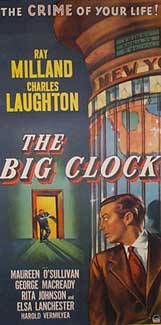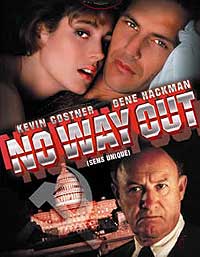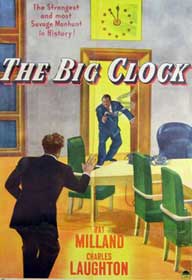The world's largest privately owned clock is in the lobby of a publishing firm, where George Straud (Ray Milland) works as editor of Crimeways Magazine, the nation's police blotter.
 That the clock is a central image & prop is strangely unimpressive. It's not a single big clock, but a whole series of clocks that keep time in different time zones, with all the clocks connected to one another throughout the office tower. Big whup. That the clock is a central image & prop is strangely unimpressive. It's not a single big clock, but a whole series of clocks that keep time in different time zones, with all the clocks connected to one another throughout the office tower. Big whup.
The central workings of the clock(s) is in the lobby, enclosing a veritable hidden office space, where some of the action occurs. The clock(s) even so never seem quite important enough to have become the film's title.
Straud's honcho boss Earl Janoth (Charles Laughton) is a total bastard, the worst boss in the history of evil bosses. A creepy rather faggoty partner named Steve (George Macready) who tries to out-evil the honcho.
For no good reason Janoth decides to fire the best man in the company & then blackball him from the entire publishing industry.
Far from being angry or depressed about it, George realizes he had given up a close relationship with the wife he loves, trading potential happiness with her for devotion to his occupation. Getting fired is a blessing in disguise.
But George misses the train for his seven-years-late honeymoon with Georgette (Maurine O'Sullivan), & ends up bar-hopping & binging with Paula (Rita Johnson), a beautiful woman he met by chance & who has a serious axe to grind with Mr. Janoth.
George, eventually flying off to reconnect with his family, has no idea he will soon be identified as the last man to see Paula alive. Jantho kills her in a shockingly brutal scene, but together with his creepy partner Steve manages an effective cover-up.
George is soon telling his wife & everyone more & more whoppers, making it difficult to care about what happens to him as the plot thickens. Suspense does heighten while two clues are being sought, one that will successfully frame George, & one which will point to the real killer. With trigger-happy guards all over the place, George hides inside the giant clock.
As a crime noir The Big Clock is quite good in structure & Milland is an actor of considerable merit. And of course Laughton is wonderful to watch act whether a good guy or a scoundrel.
One weakness of the story is the character of George, whose drunken infidelity is so wrong & foolish that he almost deserved the trouble he finds.
The b/w cinematography is gorgeous, & the array of fine character actors a delight. Janoth also has a silent henchman played by Harry Morgan who is surprisingly menacing. My favorite character by far was Elsa Lancaster as the artist whom George has been collecting, though he does not know the artist personally, & did not realize he not only met her in a junkstore, but mistreated her into the bargain.
When the police become convinced the artist has encountered the murderer, & with her art skills could easily do a painting of their chief suspect, she most amusingly is reluctant to give evidence against one of the few people in the world who ever collected her paintings. She's just splendid in this role, upstaging everyone, including her gifted real-life husband Laughton.
The ending is cleverly staged & while the film's overall effect is not quite first-rate like the best-known film noirs, it has a classic veneer & well worth tracking down.
 In Kenneth Fearing's 1947 novel, the murder victim Paula was a lesbian, but that vanishes from the film version.
In Kenneth Fearing's 1947 novel, the murder victim Paula was a lesbian, but that vanishes from the film version.
Homosexuality plays a larger role in the remake No Way Out (1987) which in outline scarcely seems like the same story, having become infused with Cold War politics within the Pentagon setting that supplants the original film's publishing firm.
Instead of a big clock there's a computer marking time. Instead of a magazine editor there's a navy lieutenant (Kevin Costner) who becomes involved with a woman (Sean Young) who he did not know was the mistress of the Secretary of Defense (Gene Hackman). The killer's partner who orchestrates the cover-up is played by Will Patton, who is evil incarnate, & definitely homosexual.
As played by Patton, or even by Macready in the original b/w film noir, this idea of the machiavellian faggot can be downright offensive, but does originate in an alcoholic lefty poet's 1947 novel, written at a time when fascism was commonly linked to homosexuality, however unreasonably.
Essentially No Way Out's faggot fascist in love with a murdering military man is a relic of the source material, an attitude which, even in this radical revision of the story, survived because negative stereotypes of gays still persist. The screen adapters of two distinct generations never thought to question it.
As tends generally to be the case, the original is the better film, but the remake's pretty good too. Our innocent lieutenant has a finite amount of time to find the real killer, & it makes an effective suspense tale, with good acting all round, not too badly hampered by a slow start, a few too many cinematic cliches, a "surprise!" climax that borders on goofy, & an overall "imitating Hitchock without restraint" tone.
copyright © by Paghat the Ratgirl
|

 That the clock is a central image & prop is strangely unimpressive. It's not a single big clock, but a whole series of clocks that keep time in different time zones, with all the clocks connected to one another throughout the office tower. Big whup.
That the clock is a central image & prop is strangely unimpressive. It's not a single big clock, but a whole series of clocks that keep time in different time zones, with all the clocks connected to one another throughout the office tower. Big whup.